Setting Aside Minor Rules for Substantive and Free Communication. The City of the Future, According to the Iwasawa Brothers.
Setting Aside Minor Rules for Substantive and Free Communication. The City of the Future, According to the Iwasawa Brothers.

The Iwasawa brothers have situated their office and workshop in east Nihonbashi, an area populated by a number of creative types in recent years. They are a team specialized in the creation of highly-original spaces that fuse digital and analog elements, following a catchphrase of “intriguing and fun relationships between things, concepts, and people.” In an era when the ideal form for communication is being revisited, we asked about their thoughts from their position on the front lines as “location creators” who work on gathering places, as well as their ideas for the future.
We spoke with both elder brother Mr. Hitoshi Iwasawa, and younger brother Mr. Takashi Iwasawa. (Top photography: TADA (Yukai Studio))
We formed our current style via blending the fields we each excelled in.
-First, please share the story of how two brothers came to work as a team.
Takashi Iwasawa (Takashi): When we were in college, we went to different universities of art. But we lived in Chiba, so it was quite a way to either college. So my older brother was got a room in Tokyo, first, and later on it ended up working out for me to live with him. I’ve been a freelancer since that time, and was working on video projects back then. I got help from my brother sometimes, since he was nearby. And the other way around, I worked on PC stuff for my brother when he worked part-time in architecture. We started cooperating on stuff little by little, from our time in college onward.
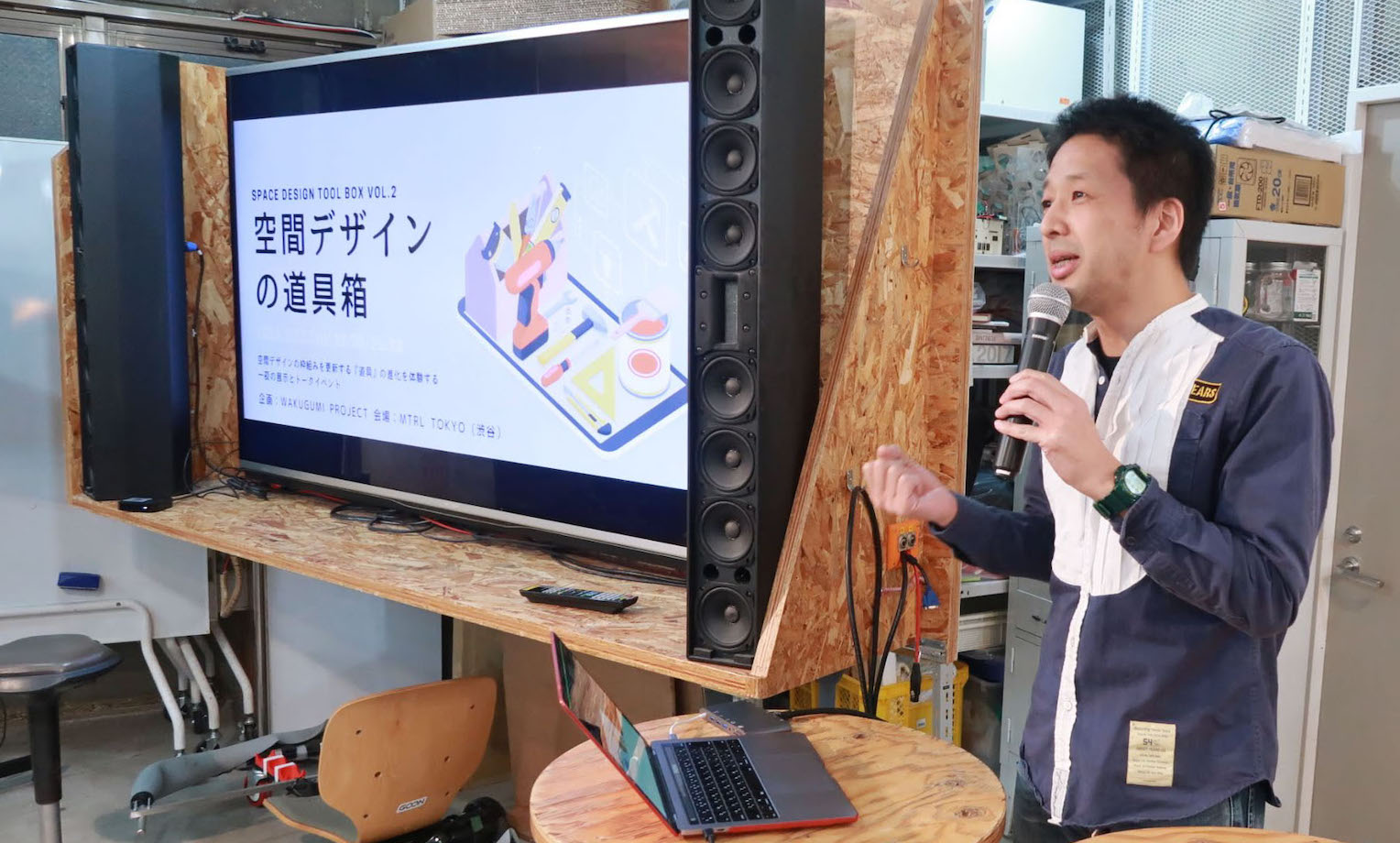
The younger brother of the team, Mr. Takashi Iwasawa manages web-related content and direction. He is often the speaker at events, as well. (Image provided by: Iwasawa Brothers)
-Was there anything that motivated you to incorporate, in particular?
Hitoshi Iwasawa (Hitoshi): The direct cause was a client that required us to have a corporate identity for business with them, and we incorporated at that point. Around the time we incorporated, my brother and I often got entirely separate projects. I did real-world creation like storefront design, and he did TV program-linked website production and so forth, primarily. About 80% of what we did was work on separate projects, with the remaining 20% consisting of follow-ups on each other.
Takashi: After that, the world gradually shifted toward combining digital elements into space design, and the projects we got changed, too. It was still the i-mode era when I was involved in TV program production, and even when we paired real-world things with digital, it was basically just placing selection buttons in event venues (laughter). But with communication undergoing fundamental changes after smartphones appeared, we started to see more projects pairing both of our fields, like work on creating original equipment to link entire events with technology. Since that period, I feel that there has been value in working together in the company.
-So your work in each of your fields ended up blending as the era progressed.
Takashi: Yes. We’ve gotten more opportunities to work as a sibling unit. So while our company is called “Battanation,” lately, it’s easier to lead with “Iwasawa Brothers,” since it’s comprehensible at a glance. We updated our website about a year ago, and went with a design where the name Iwasawa Brothers really pops out at viewers (laughter).
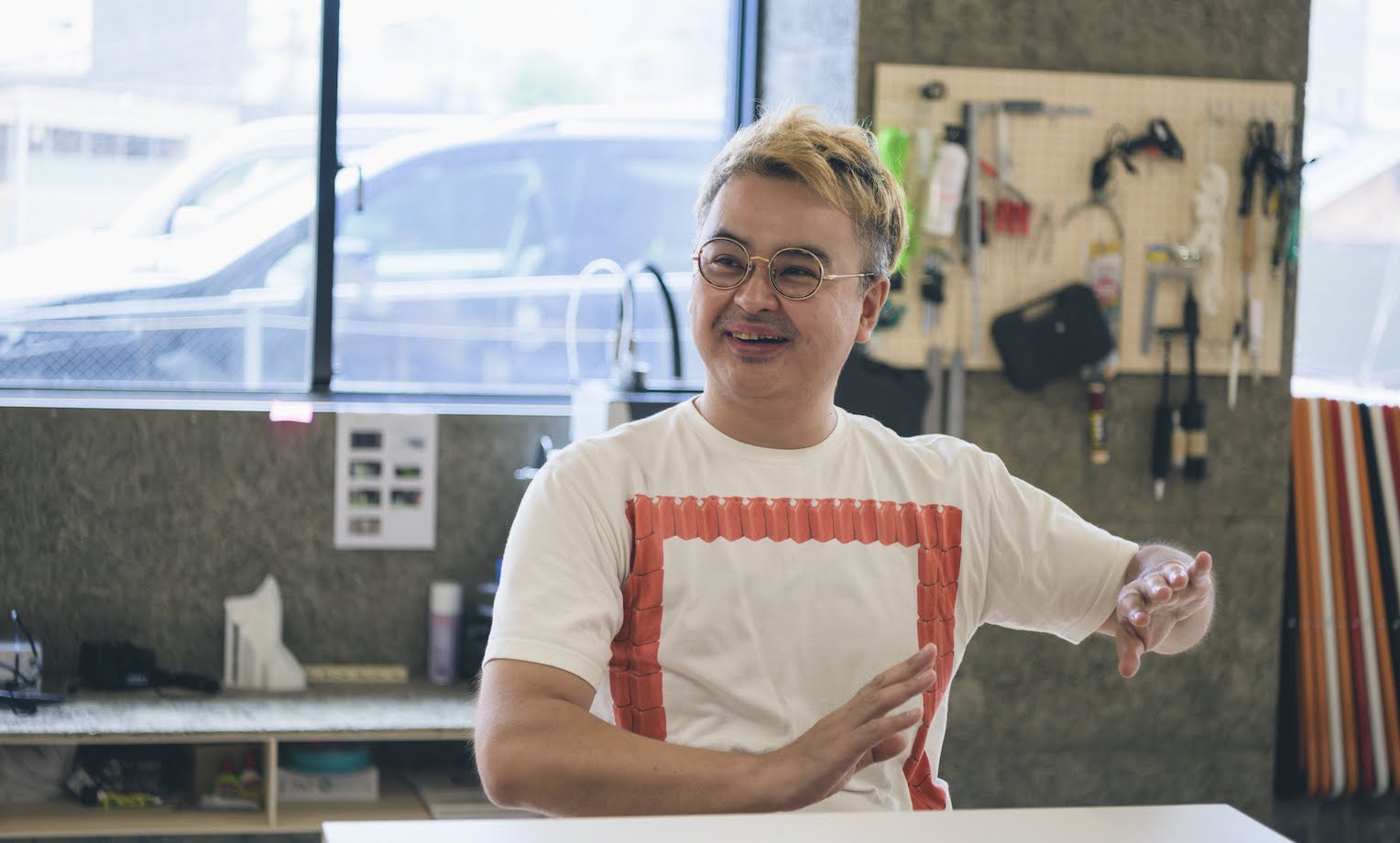
The elder brother of the team, Mr. Hitoshi Iwasawa manages three-dimensional object design (Photography: TADA, (Yukai Studio))
-What do you prioritize in your work?
Takashi: I’m always very aware of making the work “fun” regardless of what type of project I’m working on. I create a lot of activity hubs for people and organizations, and I don’t think you can produce a design that will yield good work if the people involved in making it don’t feel positive about it.
Hitoshi: I think it’s important to avoid constraining your imagination. For example, we produce furniture. But I want the furniture itself to give off a sense that “you can use me however you like,” out of a desire to avoid limiting the ways it could be used. I always want to create something that offers ideas that transcend the boundaries of everyday thinking, when I work.
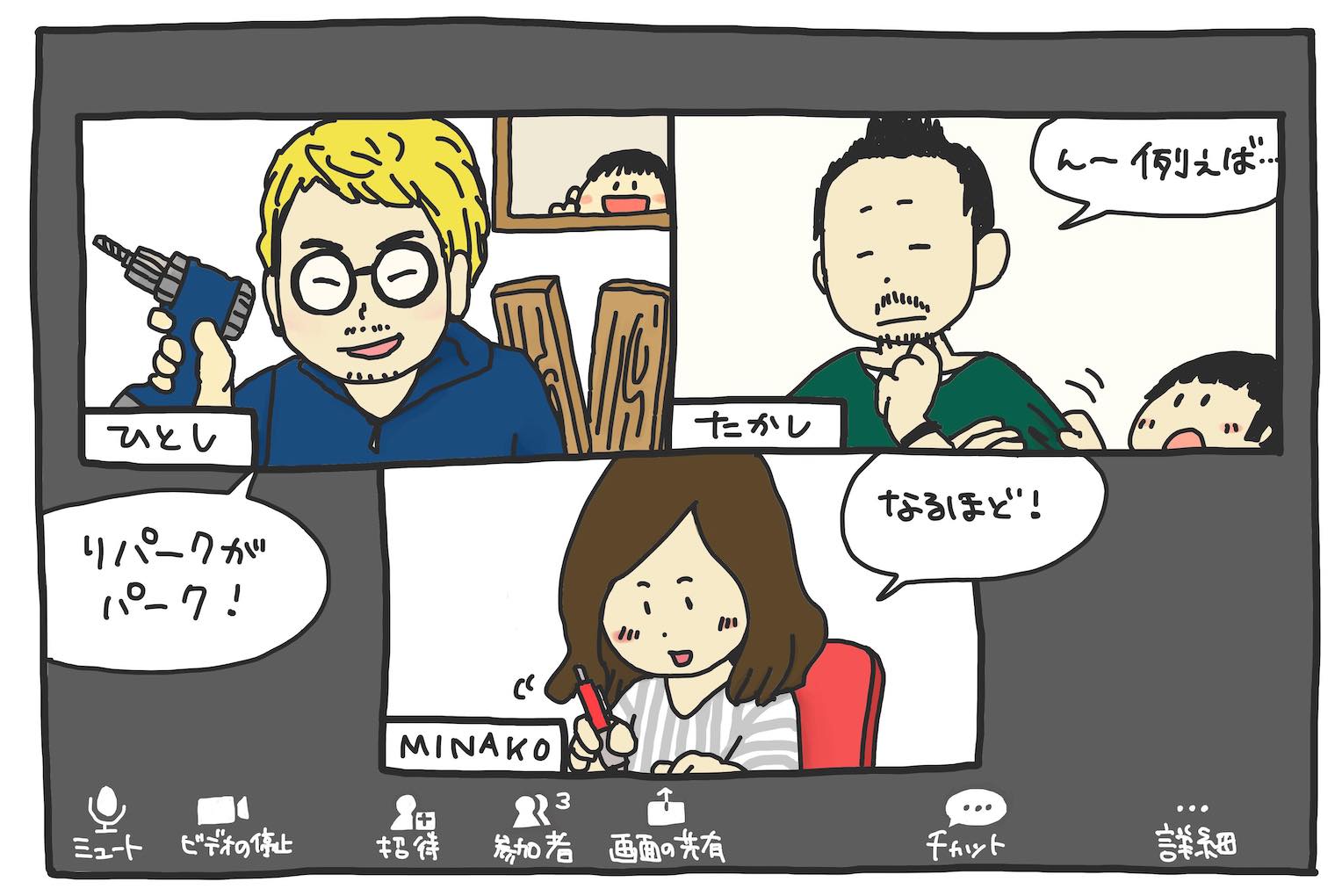
This interview was conducted via Zoom (Illustrations: Nana Aizawa)
The Iwasawa Brothers’ style of “setting aside minor rules.”
-Are there any incidents that embody your philosophy, in your recent work?
Takashi: Last year, we worked on the design for the “Kamisu Disaster Prevention Arena” in the city of Kamisu, in Ibaraki Prefecture.
They gave us a lot of “freedom” on that project. We had several discussions with the project team about how we didn’t want to use fixed positions for furniture. So we went with movable furniture, to allow for freedom of layout changes when the facility functions as an emergency shelter. It’s not just moveable, either; for example, the flat sofas can be used as simple beds during emergencies, and people can think of a variety of uses on their own with some ingenuity.
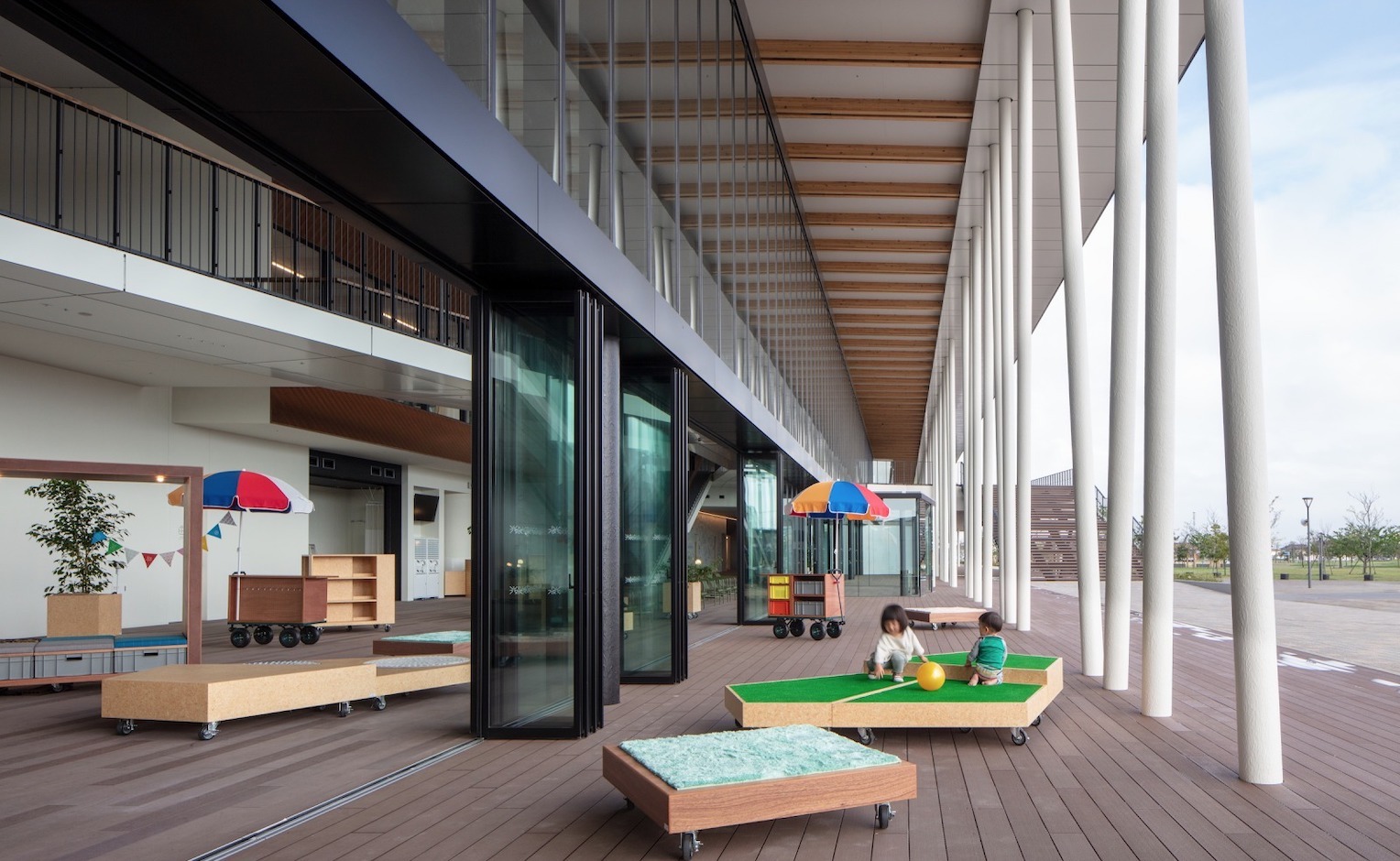
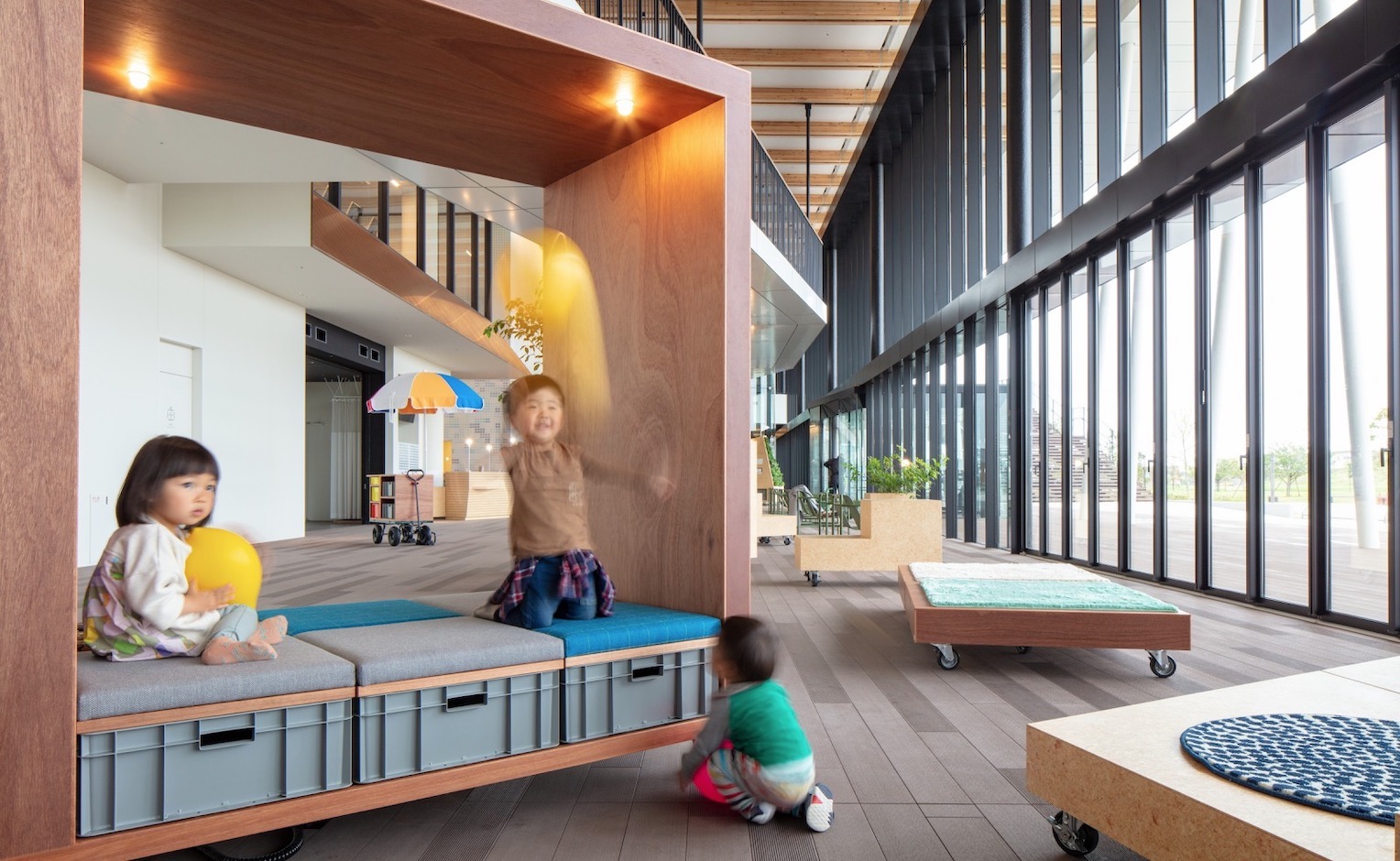
Furniture the Iwasawa brothers worked on in the “Kamisu Disaster Prevention Arena.” It is distinct in its use of plastic containers as well as its movability, to accommodate a variety of uses during disasters. (Photography: Akito Goto)
Hitoshi: The “Kamisu Disaster Prevention Arena” is a public facility, and functions as a community area for residents during normal times. We tend to have a strong preconception of public facilities as managed locations, so it seems quite novel for people to have furniture they can move or change to suit their purposes there. A lot of people are surprised, and say things like “is this really a public facility?” (Laughter)
-I thought it was amazing to use such a friendly design for normal times for a community facility, while still functioning as a disaster facility.
Takashi: Since we don’t make furniture especially for use during disasters, I suspect there are areas where it’s lacking from a functional perspective alone. The furniture on its own doesn’t provide enough beds for its full occupational capacity, for one. But you tend to get something that isn’t useful during normal times when you envision based on disasters; you end up with something that suddenly shifts to full capacity exclusively during major incidents. That makes everyone feel the facility is cut off from their everyday life, and prevents them from feeling personally about it. Using something during a disaster, after you’ve also handled and made changes to during normal times. That was what we hoped for when we built it, and we ended up with this facility.
-It sounds like you proposed the idea based on ideas of extending everyday life into disasters.
Takashi: I hope it works that way. It’s quite tough to change big concepts like what disaster facilities should be, but it’s easy enough to propose changes for removing “minor rules,” like fixing furniture in place and rearranging when disasters strike. It’s true that some people will speak up about things getting harder to manage as you remove minor rules, but I think we should address those with ingenuity and by revisiting ideas in multiple passes.
The affordance of an era that resists constancy.
-What inspires these wide-ranging ideas for the two of you, in your daily lives?
Hitoshi:Well, let’s see… I’ve always thought about “things” as part of my work, but I often get ideas by accidentally connecting two things right in front of me, like when wandering through home improvement centers, for example.
Also, I like thinking in a way where I throw extreme ideas into the air and see what comes back down to reality. Take train seat belts, for example. They’re actually hard for senior citizens to sit with, and they might be hard to stand with, but I was wondering if it might actually be easier standing. But since there’s no way we’d make senior citizens stand, why not try a high stool type seat? That might be perfect. And that’s how my ideas tend to fall out, in general.
Takashi: We have a lot of “complaints” for the world at large (laughter). We comment to one another about things that are hard to use, a lot. The ideas we come up with for fixes might be skewed by our perspectives and ways of thinking, and my brother’s ideas by design experience.
For example, you often see drinks left on top of mailboxes, don’t you? Which is to say, mailboxes are a setting and place where you want to set down drinks. A lot of my ideas come from observing the “affordances (*in this case, meaning the actions a user is led to by the design of a thing)” created by these artificial items. Going forward, I want to focus on the traces left after the thing eliciting the behavior is gone, like the lingering aroma of an affordance. I think we could create something intriguing from the traces of people’s activities.
Hitoshi: There are elements of affordance in the “wheeled furniture” we make. Emphasizing the affordance of it being wheeled lets us use “having wheels” and “movability” as part of its appeal, and encourages users to be inventive. That’s what we build for.
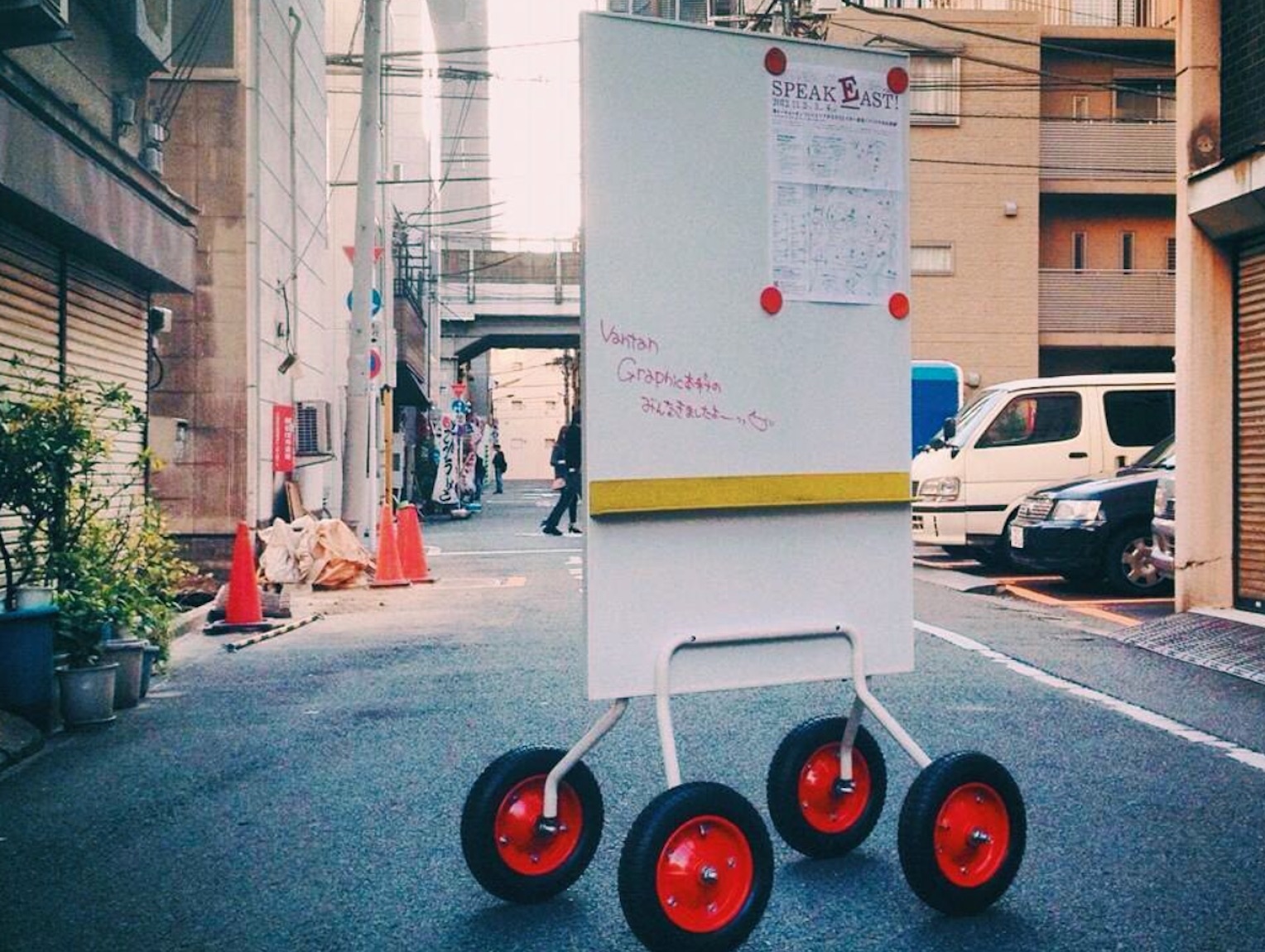
A whiteboard as an example wheeled furniture item. It incorporates an affordance-oriented perspective, with large wheels to lead users to ways of using it. (Reused from the Iwasawa Brothers’ Instagram)
Takashi: A while ago, I saw an older person talking on a smartphone while facing the wall. It was fascinating, and I realized they were probably from an era when they would’ve been used to talking on land line phones at home. They were acting that way unconsciously. But for a generation that’s used to walking around the room freely with cordless phones, or a generation that has only ever known smartphones, I think the way that person felt in the first place would be incomprehensible.

A man talking on the phone, facing a wall (Image provided by: Iwasawa Brothers)
So you need to observe with an awareness of affordance, and also of the differences in behavior that are rooted in experience. In particular, there are huge generational differences in experience with communication tools, and I feel we need to improve our accuracy in observing users.
Hitoshi: The barriers in creation of universal design are on the rise. For example, online communication is spreading rapidly, like with Zoom and so on, but it’s inconceivable that everyone in a conference could physically speak face to face with everyone else. I feel that we’re in a transitional period as our current mode of communication enters the next generation.
-We’re actually doing this interview over Zoom right now. New hires at companies that join and think of this as standard will probably also have a different attitude toward communication, won’t they?
Hitoshi: I think we’ll be hearing some complaints that it’s hard to talk in conference rooms (laughter).
We love the perfect level of distance and diversity in this city.
-You both communicate as you work on space designs, and you’re deeply connected to local communities in your work. What’s the story behind that?
Takashi: There was a movement called “Central East Tokyo (CET)” starting in 2003, centered in the east Nihonbashi area. I think that participating in it spurred us into involvement with the city. We operated and provided spaces for large-scale art events, symposia, artist exhibits, and so on using spaces throughout the city and empty buildings.
Hitoshi: We were originally located in Koamicho in Nihonbashi, and that area has a lot of smaller buildings and shops, with a tight-knit community you wouldn’t expect in the city center. At the time, we had an office on the sixth floor of a building, and felt that it would be better to have a street-level office that was closer to the city’s atmosphere. So five years ago, we moved to a location in the area between Asakusabashi and Bakurocho.
-So did fondness for Nihonbashi play a role in your choice of a location nearby, even after the move?
Takashi: Yes. The community in Koamicho was nice, and we struggled with leaving it, but it was also an era when it was less of a concern to be a bit further away, since social media had spread to everyone. We’re still connected to the area, and don’t feel very far away. We also still participate in local events in Asakusabashi even after the move.
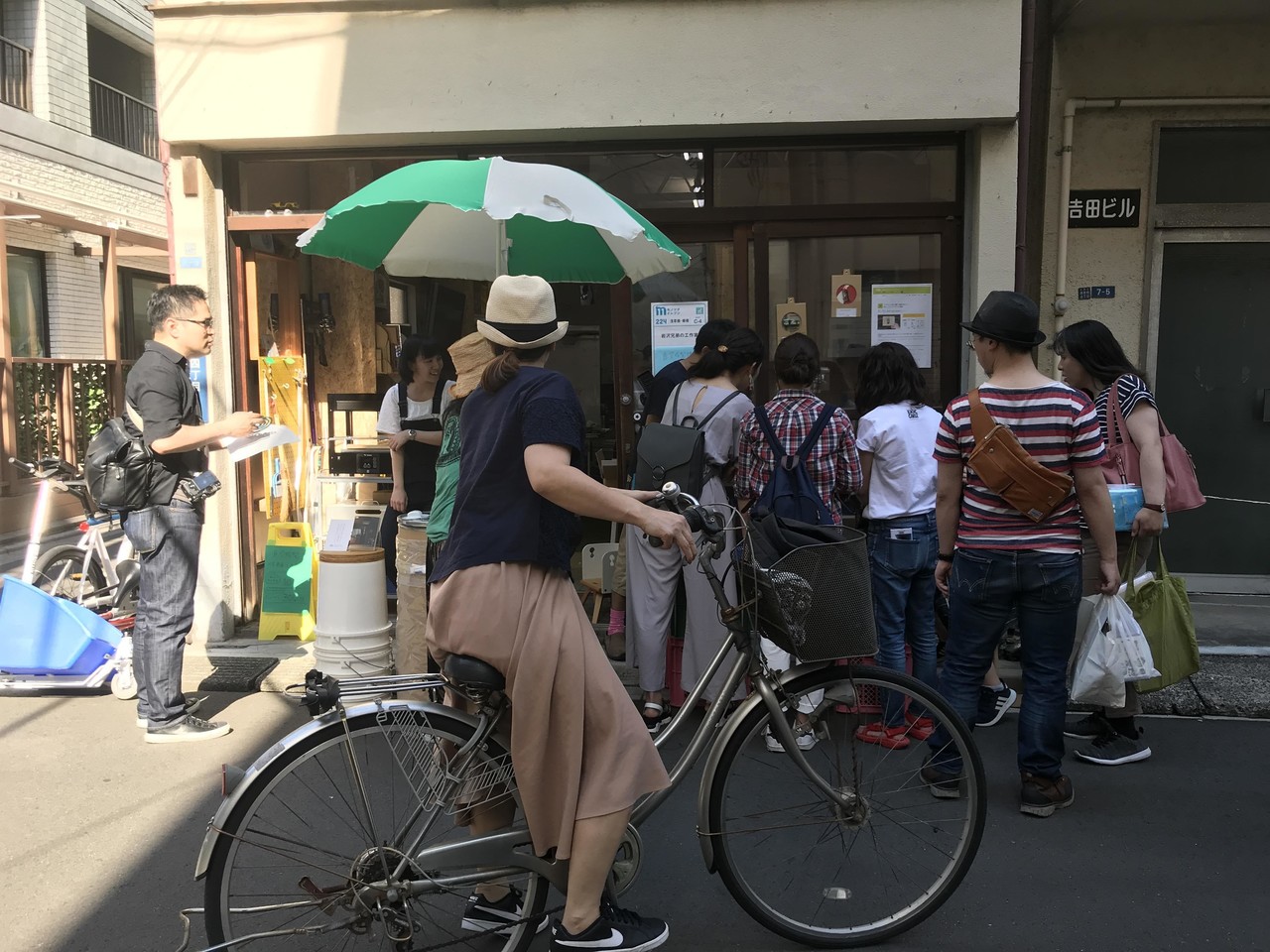
A scene from the “Monomachi” event from last year, centered on craftsmanship (Image: Reused from the Iwasaki Brothers’ note)
Hitoshi: The east Nihonbashi area has this sort of sense of “space,” and I like that. It’s not neatly organized, so there’s room for ideas to grow, you might say. It’s also appealing that it’s a diverse area, with office buildings, hotels, retail shops, and people who live there as a home town. I think it’s the ideal environment for creative work.
Takashi: I’m also fascinated by how people who have lived there a long time naturally get caught up in new things, possibly because of their diversity. Even while maintaining a historically-established roadside restaurant, a young manager might sell bento boxed lunches in a commercial facility, or run a food truck at events. I think it’s amazing how proactive and light on their feet people are.
-Do you ever use your relationship with the city in your work?
Takashi: It’s rare for it to directly link to other business, but I did use my experience from Nihonbashi when working on a project with the Shibuya area, in the past. For example, I’ve handled the video production work for the “Japanese sake tasting walk” event in Nihonbashi for years, and I’m glad to have learned a sort of “etiquette” for making cooperative progress on plans, working with local businesses and customers, other creative companies, and the diverse range of people who live in the city. You can’t build a relationship with local residents overnight, after all.
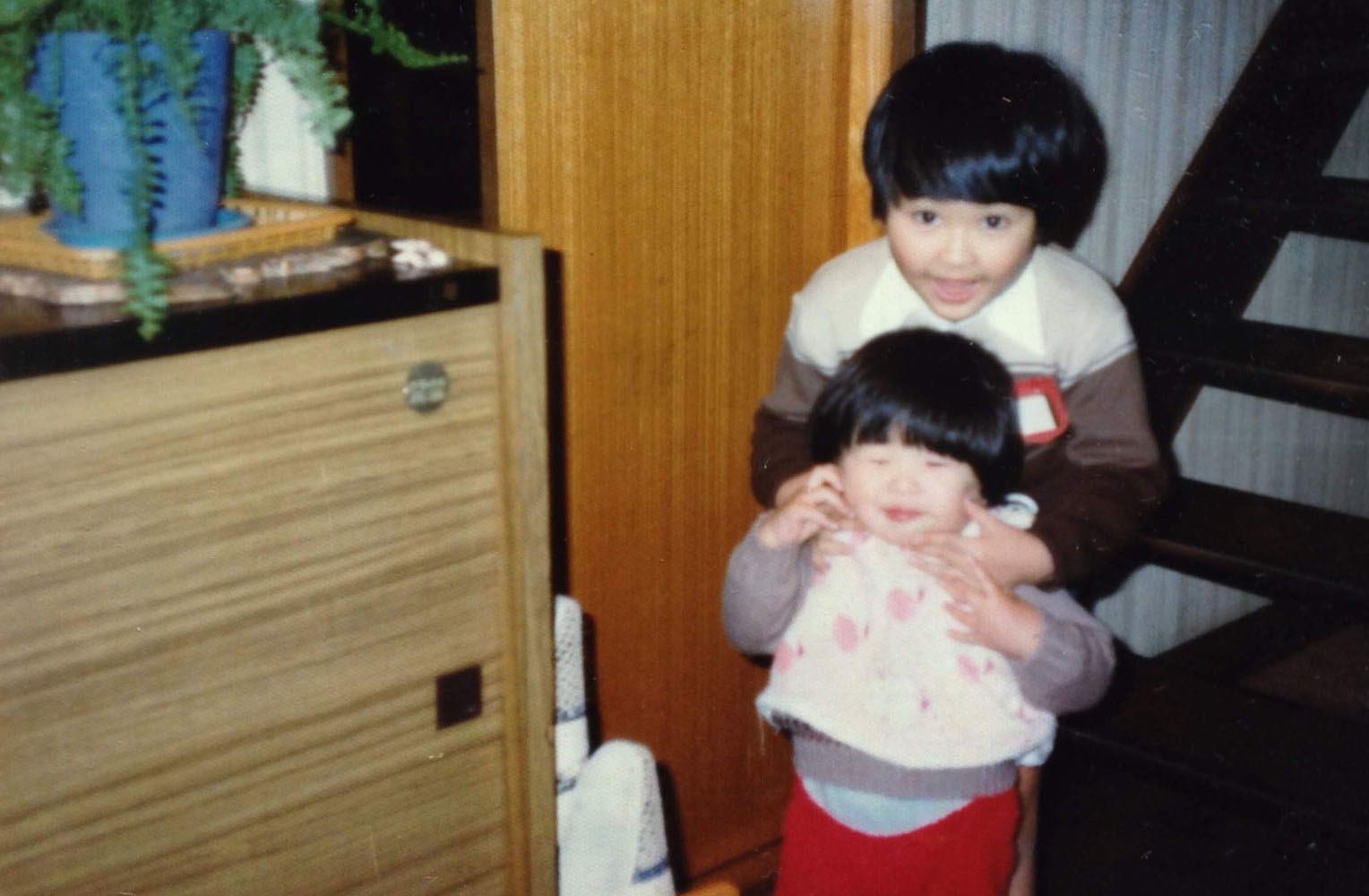
The Iwasawa brothers when they were children (Image provided by: Iwasawa Brothers)
Observing the next form communication will take.
-I feel like the forms space creation and communication take are currently undergoing major changes. How do you view that situation?
Hitoshi: We’ve been talking about that topic a lot among ourselves, lately. Seeing the current situation reminds me of the “Activity Sake” event we held in Nihonbashi after the March 11th earthquake and tsunami. With all events shut down, the Nihonbashi festivals were cancelled, and everyone was lonely and depressed. So we put on that plan after talking with local compatriots about how we wanted to do something.
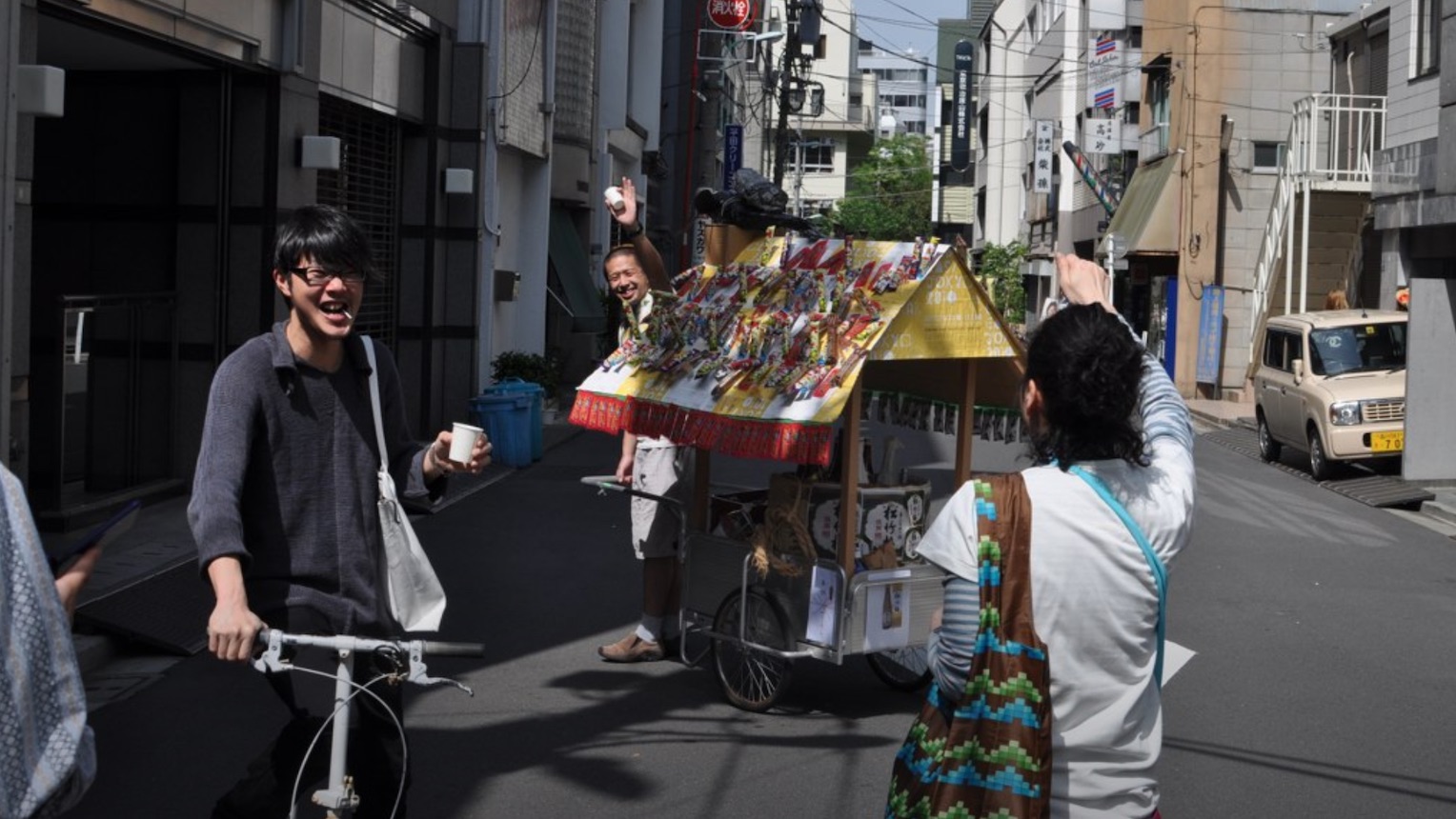
A scene from the Activity Sake event, held after the March 11th earthquake and tsunami (Image provided by: Iwasawa Brothers)
Takashi: Yes, exactly. We got sake brewers to provide sake and kegs, and built a handmade awning over a hand cart loaded with those. Then we stuck snacks all over the awning (laughter). And we pulled that along on a course festival parades follow, and to the offices of people we knew, in a procession. It wasn’t a sponsored, official event; we just visited people we knew, and held it as a personal art project, ultimately.We published our agenda and route on social media using Google Maps, and a lot of people showed up to greet us with smiles.
It all reminded us that you don’t always have to do a big event when you want to do something creative for the city. Just walking through the city changes the scenery in itself, and it can genuinely move people emotionally. To put it another way, “action is something that we should initiate when out in the city.” The experience of fostering the communication everyone longed for at the time - as well as a conversation on how we all had to do our best in bad times – is still a strong memory for me.
Hitoshi: But now, unlike the last time, we have no face-to-face communication and the activities open to us are restricted. I do think that online meeting tools are generating new possibilities, but saying “it’s tough all around” online doesn’t feel like fully sharing, and I can’t shake the feeling that we’re missing something.
Takashi: But that doesn’t mean we want to say that online communication is worthless. I think that finding the missing pieces in online communication and figuring out differences from whatever face-to-face contact satisfies in us – as well as fusing that with online communication - is vital in order to create the next version of the real world.
So right now, rather than rushing to respond that “this sort of new age is coming!”, we feel that what we can manage is “carefully observing” this transitional period in the mode of communication. Building on those observations, we want to become capable of offering new, creative approaches when people’s thinking and the nature of communication make a full change.
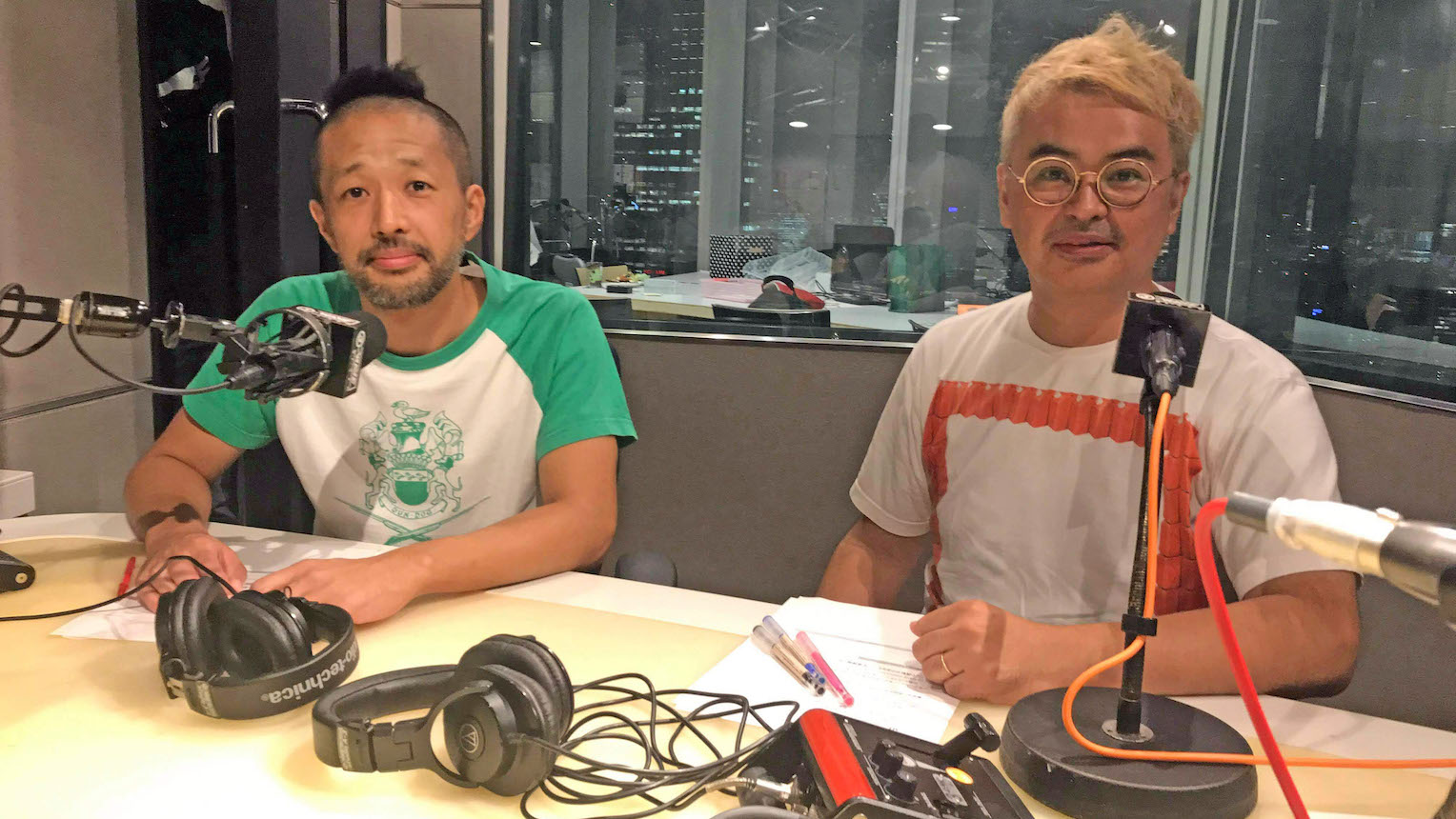
The brothers during a radio appearance (Image provided by: Iwasawa Brothers)
We want to spread “city prototyping” in Tokyo.
-Please tell us about the next challenges the two of you want to take on.
Takashi: We both have small children, so we’re interested in creating spaces and play areas for kids. They make a lot of play areas now with set play styles, and that feels off to me, somehow…
Hitoshi: I get that. The way to play with the toys in children’s spaces is usually set, too, and I wish there were places that let kids use their imaginations freely. Like, just having toys laying out, and letting them think “maybe you use it like this?”
Takashi: In the sense of not fixing the way things are used, I think we should be freer in our thinking about things like architectural sites and their uses, for example. I think it might be nice if they were made into limited-time parks and play areas before construction began. If we made a site into a park for a while then closed it before putting up a building, it would suddenly expand the roles and potential of construction sites really broadly. That’s in contrast to following our current, set pattern of deciding construction details, clearing the lot, and then putting up signs for the planned construction.
-I see. You’d fit the closure of the land onto a timeline in the construction plan, then.
Takashi: I think we should consider something like “city prototyping” during city planning. I know that city planning is a heavy subject and governed by a lot of laws, so it isn’t easy to generate movement in the field, but this is an era of frequent unanticipated events. Things that seemed set to go smoothly in plans sometimes collapse into themselves on a fundamental level. So I think it might be a good idea to have somewhere to experiment on a smaller scale, and see whether a plan will really sit properly with an area.
And instead of just having sites act as parks, I think it would be alright to even have a corner for people to experience a preview of the city after the building’s construction, using AR or VR or similar technologies. People would definitely feel more familiar with city planning if they could learn about how their city will change, while having a good time.
-That does seem like it would help residents feel familiar with the structure after its completion.
Hitoshi: It’s difficult for people to take building architecture as a personal matter, especially in urban areas. But I think it would totally change the value of a building if you take a long view of raising awareness of it, as “that building where the park that everyone enjoyed for a while was.” We often see temporary signs saying “Mitsui Repark” that tell us a parking lot will be going into a site before construction, but you could do all sorts of things if you made that into “Mitsui Park” instead, couldn’t you? (Laughter)
I think it would be great to have construction processes that involved keeping the park and putting the building on top of it or some other place, and it seems like cities may eventually need to be flexible enough to have a flexible outlook on changes to plans based on prototype responses.
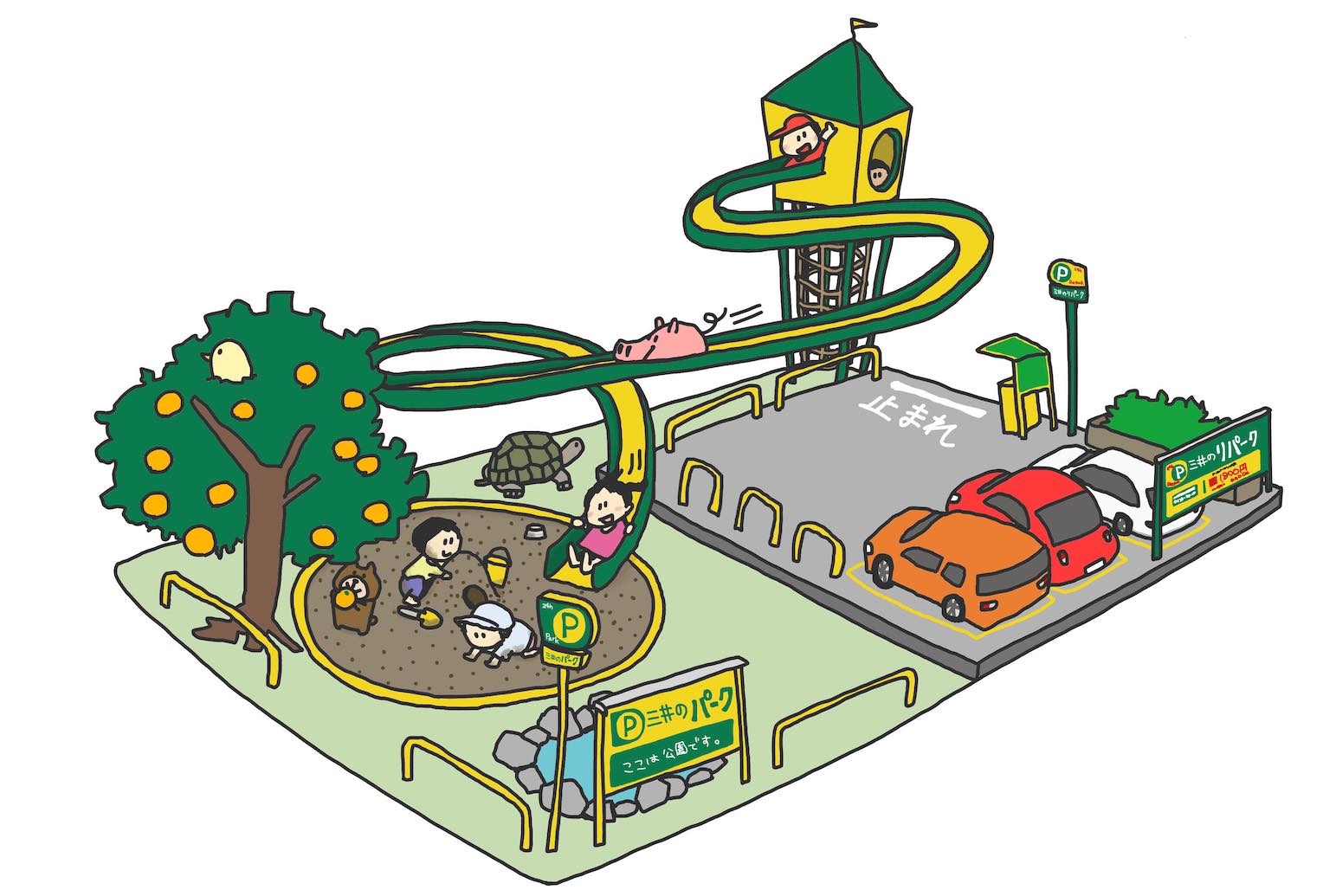
A concept drawing for “Mitsui Park” (Illustration: Nana Aizawa)
Takashi: I think we excel at repeated prototyping while connecting with all sorts of communicators, so I’d be delighted if I could expand that field into urban development in the future. In the sense of the “removing minor rules” we like to keep in mind, as well, there still seem to be a lot of places we could make changes in city building practices. So I want to contribute in some form.
Interview and text: Minako Ushida (Konel)
Iwasawa Brothers
A team that holds to a motto of “intriguing and fun relationships between things, concepts, and people,” while working in site creation for locations that give people and organizations a foothold for their activities. They excel in communications design using both digital and analog tools, as well as 3D object design for spaces, furniture, and more. In addition to a wide range of work in office spatial design and more, they are also active on a variety of other fronts, including production of unique furniture and planning of local events.




